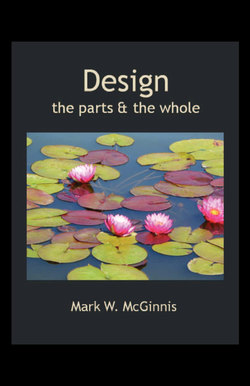Design

Реклама. ООО «ЛитРес», ИНН: 7719571260.
Оглавление
Mark McGinnis. Design
Preface
The Big Picture
Visual Perception, Literacy, & Sensitivity
Inspiration, Originality, Creativity, Aesthetics & Intergrity
The Design Process
Line
Space
Value
Shape
Basic Color
Texture
Unity & Variety
Balance
Emphasis & Rhythm
Proportion & Scale
Color Concepts
Three-Dimensional Design
Content
Works Cited
author
Отрывок из книги
This foundation design book was written over the course of 10 years while teaching at Northern State University in Aberdeen, SD. My incentive for writing this book was not the lack of good design books available. On the contrary, a stimulus was the availability of so many good sources. My intent in the following pages is to bring together the thoughts of many people with my own. It is my hope that I have arranged the basics of design with some clarity and made them accessible to the beginning design student. It has also been my purpose throughout the text to relate the design fundamentals not only to the process of producing art but also to many areas of knowledge outside the visual arts, which are the source of inspiration for the artist and designer. I have written this text in a more personal, first person, manner than is traditional for a textbook approach. This reflects my belief that art and design is a subjective field of human endeavor, even in its basics. I have attempted to write more as an artist than an academic.
Now that I am retired from teaching, I put this book out as an eBook, hoping it may be resource for aspiring teachers and artists and possibly nostalgia for my former students.
.....
Television is a one-way experience. The viewer takes in sensory material and gives out little or none (Winn 4). It is a non-demanding activity in which the child viewer has no opportunity to discover strengths or weaknesses; where fantasies are supplied complete with auditory and visual components. There is no need for the child to create any component of the experience. Watching replaces doing, thinking, and touching. Passivity replaces activity (Winn 7). Individual experience is replaced with mass experience - experience that is being fed to millions of people at once. The sameness - the common experience, at best mediocre, at worst detrimental - becomes the child’s basic fund of mental associations from which we expect creative thought to arise. While there are more interactive aspects in electronic gaming and the Internet, it is yet to be seen how much creative thought is stimulated by these new time consuming activities.
The desensitization produced by technology transcends the visual and also deadens another critical aspect of creative thought: emotional sensitivity. Violence in mass media is probably one of the most widely researched facets of technology. Page after page was written in the sixties and seventies about television violence and its impact on youth. The fear that detective and cowboy shows would incite children to aggressive behavior now pales with cable television, electronic games, and the internet bringing appalling, sadistic and gruesome imagery and behavior into homes a cross the country. Movie after movie and game after game attempts to be more grotesque than the last, and young audiences make profitable the simulations of unending mutilations. It is frightening to me that so many people enjoy and are willing to pay to see brutality and sadism. But beyond this fear is the consequence that the bombardment of visual violence can deaden sensitivity to the real violence that permeates our lives. Genocide in some far away country, the murder across town, and the child abuse next door are all accepted as part of everyday life. Another change that electronic media is bringing to the potential artist is that of limiting the attention span. Images flash before the eyes at a phenomenal rate -a major trend in music videos, film, and advertising. This steady stream of images traps the viewer because the mind is so busy making associations to gain an understanding of the flow that there is no time to break away – no time to think. A kind of passive habituation can develop in response to this visual barrage. As a result people so habituated find it difficult to concentrate on slow moving or static visual images such as paintings or sculpture. When asked to think about what they are looking at people can become very confused. Looking and conscious thinking are no longer related activities. Instead, when one looks at an image, explanation is given through audio or by the flow of successive images. Looking at images has become a passive part of life, not an experience that requires conscious or involved thought.
.....